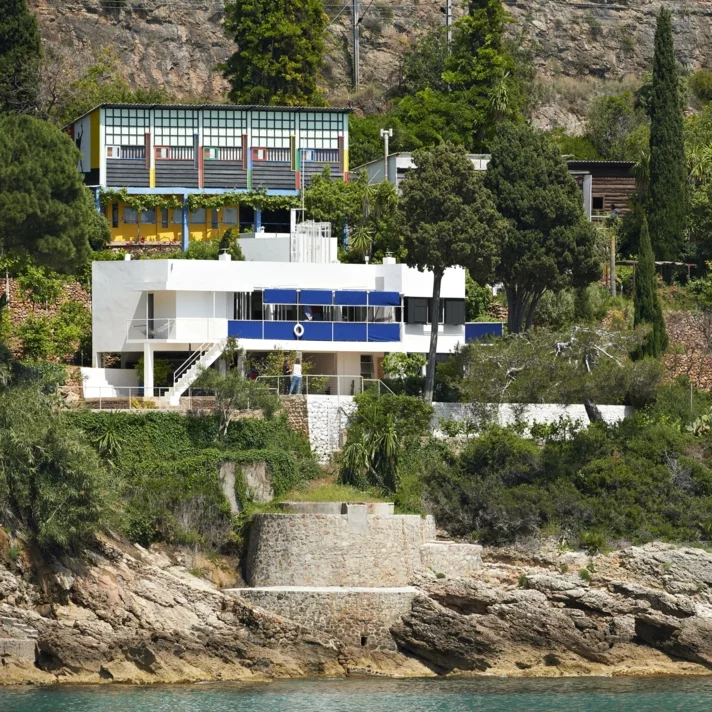History
article | Reading time5 min
History
article | Reading time5 min
Avant-garde monuments in an exceptional natural environment? Welcome to Cap Martin, in an intimate place of international fame!
The story begins in 1925, when Eileen Gray and Jean Badovici discovered a piece of land by the sea in Roquebrune-Cap-Martin. On the French Riviera between Monaco and Menton, the Cap-Martin is then a very famous place of holiday, served by the railroad since 1869.
Irish, Eileen Gray is a designer. Jean Badovici, of Romanian origin, is an architect and editor-in-chief of the magazine Architecture Vivante. They share the same vision of architecture, focused on the individual at a time of large-scale housing projects. Villa E-1027, completed in 1929, is a manifesto of their innovative approach. It is also a total work where architecture and design are intimately linked, in a subtle alliance of modernity, comfort and elegance. From the outset, the villa was designed for Jean Badovici, for a lonely, sporty man who entertained friends.
© Benjamin Gavaudo - Centre des monuments nationaux
E-1027, it is first of all intertwined initials: E, for Eileen, 10 as the J, tenth letter of the alphabet, 2 for B and 7 for G. It is also one of the first concrete architectures applying the 5 points of the modern architecture defined by Le Corbusier: the pilotis, the terrace roof, the windows in strip and the free facade. Above all, it is a habitat tailored to the individual, attentive to his needs and at the service of his enjoyment.
This villa is at the cutting edge of the avant-garde. It fits perfectly into the terraced terrain on which it sits, like a boat at the dock. And everything in the building evokes navigation! Of course, the buoy hanging from the balcony is an obvious sign, but the overall silhouette of the villa, its organization and even the furniture immerse the visitor in a still cruise. From the deck to the cabins, all the codes of yachting are present: the furniture is small and the drawers designed not to open in heavy seas. The colors of the villa are themselves a transposition of the environment: blue on the sea side, ochre on the land side, in the image of the natural rocks and the dry stone walls supporting the terraces.
© Benjamin Gavaudo - Centre des monuments nationaux
In 1938 and 1939, Le Corbusier stayed there and painted some of the walls of the Villa, with the agreement of his host, Jean Badovici. He returned in 1949, renting it to work with his team on the urban planning of Bogota.
It was at this time that Thomas Rebutato, a former plumber from Nice, began the construction of a fisherman's hut before changing his mind to build a bar-restaurant, the Etoile de Mer, in 1949. Le Corbusier came to take his meals there and became very close to the owner. Conquered by the place, he quickly obtained from Thomas Rebutato that he give him the adjoining land. In 1952, he set up his famous Cabanon, built in Corsica by the workshops of Charles Barberis. But if the Cabanon is a synthesis of Le Corbusier's work on modular architecture, it is also an extension of the Etoile de Mer, underlining the friendship between the two men through architecture.
In 1954, Le Corbusier installed a small workshop a few meters from the Cabanon. This small prefabricated building offered him a magnificent view of the sea during the work sessions that punctuated his summer rest.
Campers quickly settled on the Etoile de Mer site, seduced by the location. Le Corbusier then built for Thomas Rebutato the 5 camping units in 1957, straddling two terraces next to the bar-restaurant. Each unit, with a surface area of 9m², follows the codes and proportions defined by the architect, offering a dazzling view of the bay. This human adventure is waiting for you to prolong it in the turquoise waters of Cap Martin.
© Benjamin Gavaudo - Centre des monuments nationaux - FLC - ADAGP



